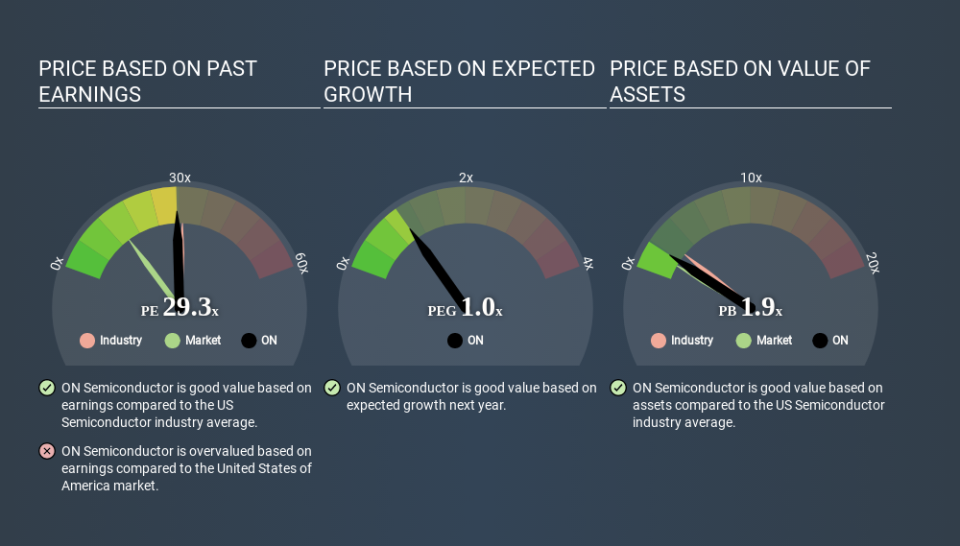What Is ON Semiconductor's (NASDAQ:ON) P/E Ratio After Its Share Price Rocketed?

Those holding ON Semiconductor (NASDAQ:ON) shares must be pleased that the share price has rebounded 38% in the last thirty days. But unfortunately, the stock is still down by 24% over a quarter. But shareholders may not all be feeling jubilant, since the share price is still down 34% in the last year.
Assuming no other changes, a sharply higher share price makes a stock less attractive to potential buyers. While the market sentiment towards a stock is very changeable, in the long run, the share price will tend to move in the same direction as earnings per share. The implication here is that deep value investors might steer clear when expectations of a company are too high. One way to gauge market expectations of a stock is to look at its Price to Earnings Ratio (PE Ratio). Investors have optimistic expectations of companies with higher P/E ratios, compared to companies with lower P/E ratios.
See our latest analysis for ON Semiconductor
Does ON Semiconductor Have A Relatively High Or Low P/E For Its Industry?
ON Semiconductor has a P/E ratio of 29.35. You can see in the image below that the average P/E (30.7) for companies in the semiconductor industry is roughly the same as ON Semiconductor's P/E.
ON Semiconductor's P/E tells us that market participants think its prospects are roughly in line with its industry. So if ON Semiconductor actually outperforms its peers going forward, that should be a positive for the share price. Checking factors such as director buying and selling. could help you form your own view on if that will happen.
How Growth Rates Impact P/E Ratios
Generally speaking the rate of earnings growth has a profound impact on a company's P/E multiple. That's because companies that grow earnings per share quickly will rapidly increase the 'E' in the equation. And in that case, the P/E ratio itself will drop rather quickly. A lower P/E should indicate the stock is cheap relative to others -- and that may attract buyers.
ON Semiconductor's earnings per share fell by 65% in the last twelve months. But EPS is up 3.6% over the last 5 years.
Don't Forget: The P/E Does Not Account For Debt or Bank Deposits
It's important to note that the P/E ratio considers the market capitalization, not the enterprise value. Thus, the metric does not reflect cash or debt held by the company. The exact same company would hypothetically deserve a higher P/E ratio if it had a strong balance sheet, than if it had a weak one with lots of debt, because a cashed up company can spend on growth.
Such spending might be good or bad, overall, but the key point here is that you need to look at debt to understand the P/E ratio in context.
So What Does ON Semiconductor's Balance Sheet Tell Us?
ON Semiconductor has net debt equal to 44% of its market cap. You'd want to be aware of this fact, but it doesn't bother us.
The Bottom Line On ON Semiconductor's P/E Ratio
ON Semiconductor trades on a P/E ratio of 29.3, which is above its market average of 14.4. With modest debt but no EPS growth in the last year, it's fair to say the P/E implies some optimism about future earnings, from the market. What is very clear is that the market has become significantly more optimistic about ON Semiconductor over the last month, with the P/E ratio rising from 21.2 back then to 29.3 today. For those who prefer to invest with the flow of momentum, that might mean it's time to put the stock on a watchlist, or research it. But the contrarian may see it as a missed opportunity.
Investors should be looking to buy stocks that the market is wrong about. People often underestimate remarkable growth -- so investors can make money when fast growth is not fully appreciated. So this free visual report on analyst forecasts could hold the key to an excellent investment decision.
Of course, you might find a fantastic investment by looking at a few good candidates. So take a peek at this free list of companies with modest (or no) debt, trading on a P/E below 20.
If you spot an error that warrants correction, please contact the editor at editorial-team@simplywallst.com. This article by Simply Wall St is general in nature. It does not constitute a recommendation to buy or sell any stock, and does not take account of your objectives, or your financial situation. Simply Wall St has no position in the stocks mentioned.
We aim to bring you long-term focused research analysis driven by fundamental data. Note that our analysis may not factor in the latest price-sensitive company announcements or qualitative material. Thank you for reading.

 Yahoo Finance
Yahoo Finance 
